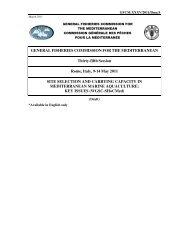English
English
English
You also want an ePaper? Increase the reach of your titles
YUMPU automatically turns print PDFs into web optimized ePapers that Google loves.
19<br />
GFCM:SAC13/2011/Dma2<br />
lifespan and the fact that they are at the top of the food web, making them more vulnerable to<br />
fishing than most teleosts (Stevens et al ., 2000).<br />
Elasmobranchs of the Mediterranean are mainly coastal species (80%) and most benthic<br />
fauna, and this is likely to be affected by fishing activities, concentrated mainly in coastal<br />
areas. Several species (12 species) are pelagic. The species of depths (15 species) are<br />
particularly benthic. Target fishing of these species is unusual in these waters. Only a few<br />
species of elasmobranch are targeted. In the Mediterranean, more than 100,000 sharks are<br />
taken as incidental catch each year. The incidental catch of these species are highly variable in<br />
time and space and using the techniques of fishing. However, the magnitude of these catches<br />
and discards is not well documented.<br />
To this end, the incidental capture of elasmobranchs by commercial fisheries has been subject<br />
to a special attention for a better knowledge of targeted and incidental catch of sharks and<br />
conservation of populations (IPOA-Shark (FAO, 1999),<br />
In this part of the document dealing with elamobranchs bycatch, we analyse the available<br />
bibliographic data on this issue in the Mediterranean and Black Sea. Results are given<br />
following geographic fishing areas, fishing gears and species or groups of species.<br />
II-5-3-2 Bycatch definitions<br />
There are several definitions of what bycatch or incidental catch is:<br />
"that portion of the catch returned to the sea as a result of economic, legal or personal<br />
consideration plus the retained catch of non-target species" (McCaughran 1992).<br />
"Animals other than the target species which are unmarketable because they are too<br />
small or for some other reason" (Alverson et al., 1994).<br />
"that portion of the capture that is discarded at sea dead (or injured to an extent that<br />
death is the most likely outcome) because it has little or no economic value or because its<br />
retention is prohibited by law" (Hall, 1996).<br />
all catches of sharks and rays in fisheries targeting other species (Bonfil, 2005)<br />
In simpler words, these definitions say respectively that bycatches are:<br />
All discards plus retained non-target species<br />
Discards of non-target species<br />
All dead discards<br />
General definitions were proposed in the frame of the SAC activities:<br />
“The total catches of unwanted animals including vulnerable and endangered species.<br />
By-catch of commercial species should be reported as associated species.’’ (Report<br />
of the ninth session of the Sub-Committee on Statistics and Information (SCSI),<br />
Antalya - Turkey, 13–16 October 2008). This definition was reported in the draft<br />
glossary of scientific terms of interest for the SAC.<br />
“The part of the catch taken together with the [authorised] target species. In a<br />
broadcontext, this includes all non-targeted catch including (by-product), discards,
















